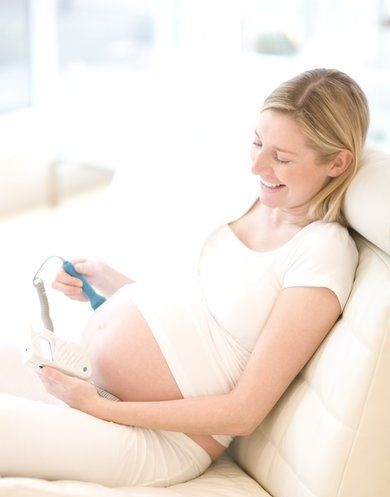Did you hire or buy a fetal doppler from us? Mums across Australia and New Zealand use Sweet Beats dopplers to hear their baby’s heartbeat at home. It can take some practice to get the handle of using at-home dopplers, so here are some tips on using your baby heartbeat monitor at home.
Finding baby’s heartbeat
The first time using your doppler is usually the hardest. Once you get the hang of it, you will find it easier. However, for the first time, we suggest you start when you are feeling relaxed and comfortable, and be prepared for it to take a bit longer than expected.
- Apply gel directly to the end of the probe. Apply just enough to generously cover the surface at the end of the probe.
- Start with the end of the probe low down on your belly. The earlier you are in your pregnancy, the closer to your pubic bone you will need to start. If you are under 12 weeks, you may even need to angle the probe towards your feet, as though aiming ‘under’ your pubic bone. As your pregnancy progresses, you may find the heartbeat higher up, and even to one side.
- Make small changes in the angle of the probe to search for the heartbeat. Imagine your abdomen is a ‘room’ and the doppler probe is a torch. Your baby’s heart is about the size of a pea relative to the ‘room’ – and is also moving around! To locate the heartbeat, you need to search slowly, and make small changes in the angle of the beam. It’s important not to drag the probe around on the surface of your belly – just change the angle of the probe, like using a joystick.

How do you know you’ve found baby’s heartbeat?
You may pick up other sounds in addition to the heartbeat when using your doppler. Your placenta, your own very large arteries, and the umbilical cord may all be detected when using your baby heartbeat monitor. You may also hear gut noises and static. You may find your baby’s heartbeat for just a few moments, and then lose it again – frustrating!
You will know when you are listening to your baby’s heartbeat because it will have a very sharp, ‘galloping’ beat that is much faster than your own heartbeat. A heartbeat range in the region of between 120 and 180 beats per minute is to be expected, but will vary from baby to baby and change as your baby grows.
Ignore and figures displayed on the screen until your baby’s heartbeat can easily be heard through the speakers. Once the doppler has a good fix on your baby’s heartbeat, its software will calculate the fetal heart rate and display it onscreen.

What if you don’t hear baby’s heartbeat?
Although it’s normally challenging to find the heartbeat when you first start using a doppler, and especially in early pregnancy, using your baby heartbeat monitor should never be a substitute for medical care. If you have any worries or concerns about your pregnancy, such as bleeding or a lack of movement, please see your care provider immediately.

Hi Can this be used on Twins ?
Hi Susan, thank you for the message. Doppler ultrasound uses sound waves to detect the movement of blood in vessels. You have to consult with your doctor to see how to use it properly for Twins.
Fetal Doppler why does it show double digits then show three digits it seems to bounce with different numbers does this mean it’s not working properly
Hey Tammy! Your baby’s doppler will be over 100 – it does take a while to get a ‘fix’ so just give it a little time. If it’s bouncing around 100, it may be picking up your own heartbeat. You can experiment by placing the doppler over your heart so you can get familiar with your own heartbeat first.